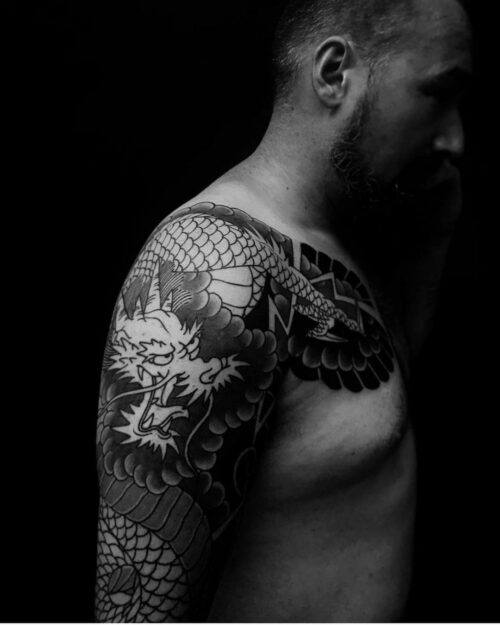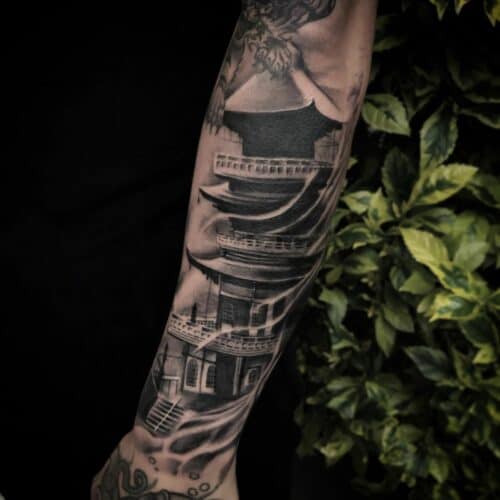There are examples of tattoos ideas that go back thousands of years — we’re looking at you Otzi Man — but when it comes to modern tattooing, it all started in Japan. With origins dating back to the Jodom period (10,000 BCE-300 CE) most designs we generally consider to be a Japanese tattoo, known as irezumi, arose during the Edo period (1603-1868).
Known for the meticulous details and depth of color that tell Japan’s complex mythical cosmology, Japanese tattoos are usually comprehensive designs that cover large portions of the body. Full or half sleeves — often continuing up onto the chest — are common, as well as designs on the corresponding areas of the legs and striking full back pieces.
Flowers, animals, dragons, warriors, and geishas are typical elements of Japanese tattoos and can be found in this collection that is sure to inspire.
1. Japanese Dragon Tattoo
Probably the most popular element in modern irezumi work, today Japanese dragon tattoos can be found around the world. Drawing its symbolic meaning from tradition, dragons represent strength, wisdom, and the force of good in the universe.

2. Traditional Japanese Tattoo
Developed through an artistic tradition that goes back hundreds of years, traditional Japanese tattoos are characterized by a gakubori which serves as the background — typically clouds or waves — with a character or scene that tells a story overlaid on top.
3. Japanese Cherry Blossom Tattoo
A quintessential part of Japanese tattoo art, cherry blossoms represent the transience of life as they bloom, fall to the ground, and are washed away. For someone looking for a reminder that all things pass, Japanese cherry blossom tattoos are a perfect choice.
4. Japanese Tiger Tattoo
Like in most cultures, tigers are symbols of strength, courage, and vitality in Japan. However, Japanese tiger tattoos are also considered symbols of long life as well as protectors against bad luck and evil spirits.
5. Japanese Flower Tattoo
In the world of irezumi, each flower has its own distinct meaning, but there are also commonalities across all flower motifs. Japanese flower tattoos generally represent the cycle of life, death, and rebirth.
6. Japanese Koi Fish Tattoo
Another element that is essential to irezumi, the koi fish is a symbol of perseverance, courage, and strength of character. The color of Japanese koi fish tattoos also adds another layer of meaning to these powerful symbols of longevity, good luck, and prosperity.
7. Japanese Snake Tattoo
Like their mythical relative the dragon, in Japan, snakes are symbols of wisdom and strength as well as rebirth and change. Like dragons, Japanese snake tattoos are also particularly spectacular for the depth of detail achieved in the seemingly endless layers of scales the wrap their coils.
8. Japanese Wave Tattoo
Possibly the most famous piece of Japanese art in history, Hokusai’s Great Wave, is instantly recognizable and demonstrates the symbolic power of the sea in irezumi. In the same way, Japanese tattoos with waves represent constant change and our need to adapt as life, like the waves, ebbs, and flows; rises and falls.
9. Japanese Demon Tattoo
Present throughout Japanese folklore, demons — typically known as oni — take on a variety of negative characteristics in these stories. However, despite these negative associations, Japanese demon tattoos are thought to ward off evil spirits and bad luck, giving the wearer an added level of metaphysical protection.
10. Japanese Samurai Tattoo
Elite members of the Japanese warrior class, samurai lived by a strict code of loyalty and duty. Unsurprisingly then, Japanese samurai tattoos represent courage, honor, respect, and nobility.
11. Japanese Cloud Tattoo
Used as the gakubori, or backdrop, on which other animals, characters, and scenes are overlaid, Japanese cloud tattoos represent the heavens where many of these mythical tales unfold.
12. Japanese Peony Tattoo
Known as the “King of Flowers”, the peony is a symbol of wealth, good fortune, and prosperity. However, Japanese peony tattoos, with delicate and complex petals, can also represent masculine, devil-may-care energy.
13. Traditional Japanese Dragon Tattoo
Unlike their greedy, gold-hoarding counterparts in the west, dragons in Japan are often benevolent beings that manipulate the powers of the universe for the benefit of humankind. In this understanding, traditional Japanese dragon tattoos are good luck and a sign of the wearer’s striving for wisdom, generosity, and goodness.
14. Japanese Crane Tattoo
Like the dragon and koi, cranes are also considered holy animals in Japanese folklore. Associated with longevity and prosperity thanks to their fabled thousand-year lifespan, cranes done in Japanese tattoo style are powerful symbols of good fortune.
15. Japanese Oni Tattoo
Typically portrayed with horns in a variety of colors, in Japanese folklore oni are demons that are vicious, violent, and cruel. In the world of irezumi though, Japanese oni tattoos can serve as protection from these very demons and misfortune they sow.
16. Japanese Temple Tattoo
A bit more straightforward than some of the other design elements common in irezumi, Buddhist temples are holy sites devoted to worship and prayer. Unsurprisingly, Japanese temple tattoos demonstrate the wearer’s devotion to living a pious life.

17. Japanese Water Tattoo
Another example of gakubori, water often serves as the backdrop for the rest of a tattoo. Usually involving dragons, koi, frogs, or turtles, water is a fluid element that represents the constant flow of life.
18. Japanese Frog Tattoo
Considered good luck, frogs — known as kaeru — are associated with magical powers, and thanks to the fact that kaeru is pronounced in the same way as the Japanese word for return, many travelers carry a small frog amulet as good luck. Because of this, Japanese frog tattoos often feature gold coins.
19. Japanese Foo Dog Tattoo
Foo dogs, which are actually lions, can be found throughout Asia, are protectors, and are usually placed at the entrance to homes and temples. Unsurprisingly, Japanese foo dog tattoos are thought to protect the wearer from evil spirits, bad luck and misfortune.
20. Japanese Octopus Tattoo
Far less common than some of the other animals that pop up in irezumi, the octopus owes its significance to the story of Akkorokamui, a giant octopus that was powerful, often helpful but considered fickle and potentially dangerous. For this reason, Japanese octopus tattoos either represent intelligence or wildness.
21. Japanese Wolf Tattoo
Within the Shinto religion of Japan, wolves represent gods and serve as divine messengers between the physical world and the heavens. This symbolism carries over into Japanese wolf tattoos, which represent respect, loyalty, and a connection with the heavenly powers.
22. Japanese Mask Tattoo
Born from the noh theater of the 14th century, masks are central to the storytelling of the tales portrayed in irezumi. There are dozens of masks used but the most common — hannya masks — represent a woman’s anger and jealousy, although Japanese mask tattoos are often considered strictly works of art beyond these narratives.
23. Japanese Cat Tattoo
While there are some examples of cats in irezumi, more often Japanese cat tattoos portray maneki neko, or the beckoning cat. This small figure, often seen in shops and homes, is believed to bring good luck and fortune.
24. Japanese Alphabet Tattoo
Just like any script, the meaning behind the tattoo of a Japanese alphabet depends on the words it says. But be careful, as Ariana Grande could tell you, you had better be sure about what your ink says, or you could have a tattoo dedicated to Japanese BBQ.
25. Japanese Yakuza Tattoo
At the beginning of the Meiji period around 1870, irezumi became associated with the yakuza, or Japanese organized crime when tattoos were outlawed by the government. While tattoos are no longer illegal in Japan, the elaborate designs depicting myths, legends and folklore are considered Japanese yakuza tattoos and are still frowned upon in many parts of the country.
26. Japanese Art Tattoo
Not restricted to irezumi, Japanese art tattoos represent everything from script and symbols to the anime characters that have become a global phenomenon in the last thirty years.
27. Japanese Lotus Tattoo
The lotus, or hasu, has great significance throughout Asia thanks to its prominent role in the story of Buddha. It is most often considered an allegory for life, as the flower rises from the mud, grows, and eventually blossoms into a beautiful and multilayered flower.
28. Japanese Sun Tattoo
Known as the “Land of the Rising Sun” thanks to its orientation to the west of the Americas and Europe, a red disc representing the sun has been featured on Japan’s flag for hundreds of years. More than having any meaning within Japanese folklore, Japanese sun tattoos are more representative of the wearer’s love of the country and its culture.
29. Japanese Sleeve Tattoo
Like many of the elements of Japanese tattooing, the different areas of coverage also have their own distinct terminology. Full Japanese sleeve tattoos are known as nagasode and typically start at the chest, continue over the shoulder, and down the arm. The Kubu ends at the wrist bone, while the longer tobu finishes just above the hands.
30. Japanese Back Tattoo
Known as the kame-no-kou or senaka, these full-back pieces consist of a single breathtaking scene and are incredible in their detail and complexity. Thanks to the fact that they stop at the back and include the buttocks and the back of the thighs, kame-no-kou translates to “the tortoise shell.”
31. Japanese Chest Tattoo
Known as the hikae, these Japanese chest tattoos come in two styles and cover the shoulders and portions of the chest. The deep hikae extends over the chest and surrounds the nipples while the shallow hikae stop at the shoulders.
32. Japanese Forearm Tattoo
When it comes to irezumi, there are differing lengths of sleeves for body suits, with the shichibusode and gobusode being the most common. The shichibusode, or seven-tenth sleeve stop below the elbow, giving the appearance of a long shirt with its sleeves rolled up. The gobusode, or five-tenth sleeve stops above the elbow like a short sleeved shirt.
33. Japanese Hand Tattoo
While traditional irezumi didn’t typically extend beyond the areas normally covered by clothing, modern tattoo artists can apply the same dynamic designs to the hands. Many Japanese hand tattoos feature the same characters such as hannya, oni and samurai that are found in traditional irezumi.
34. Japanese Neck Tattoo
The same rule bending that has seen Japanese tattoos jump to the hands has also seen the growth of Japanese neck tattoos. Once again, the dragons, oni and koi that are found in traditional Japanese tattoos are most popular in these modern extensions of the style.
35. Japanese Leg Tattoo
Traditionally part of a soushinbori, or full body suit, nowadays Japanese leg tattoos can be standalone pieces. Whether it starts at the hip, the thigh or the knee, the leg provides ample room for any number of designs or concepts for a Japanese tattoo.
FAQs About Japanese Tattoos
What is a traditional Japanese tattoo called?
Traditional Japanese tattoos are called irezumi and have a long and fascinating history that goes back centuries.
How long does a traditional Japanese tattoo take?
Traditionally, irezumi were applied by hand using a piece of bamboo. While this is still practiced by some artists, you are more likely to find people using modern tattoo machines. Like all tattoos, the time it takes depends on the size of the piece, so with a skilled artist using a modern machine for a full back piece, expect several five-hour sessions.
Is it okay to get a Japanese yakuza tattoo?
A “yakuza” tattoo really just refers to traditional irezumi themes and style, so there is no problem getting one of these stunning works of art. That being said, in Japan there are still certain public pools and bath houses that require people with tattoos — any tattoos! — to wear rash guards or other coverings if they enter.